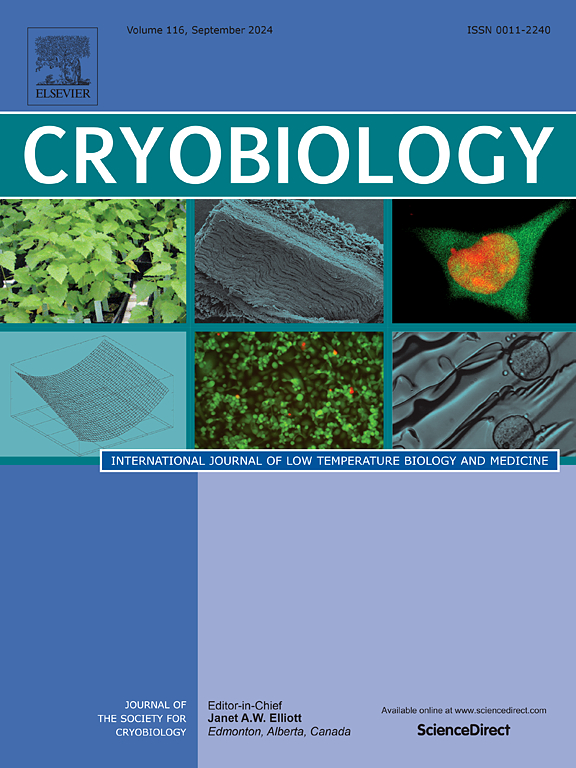探讨商业冷冻保护剂和冷冻技术对人类精子在极防水的涂有烟灰的表面上冷冻保存的运动性的影响。
IF 2.3
3区 生物学
Q2 BIOLOGY
引用次数: 0
摘要
人类精子的低温保存是低温生物学的重要组成部分,旨在为体外受精提供支持。后者依赖于尽可能多的生殖活性精子的可用性,由于伴随的冷冻损伤和冷冻保护剂的细胞毒性,解冻后精子的数量减少。克服这些障碍的一个创新选择是使冷冻界面不可湿性,通过在其表面涂上具有固有冷冻保护特性的菜籽油烟灰,延缓冰的形成,并可能提供相同的细胞内脱水和细胞外结晶速率。这可能意味着该技术可以减少或避免对有害冷冻保护剂的需求,但要达到这样的发展阶段,必须澄清经认证的冷冻保护剂和冷却速度对烟介导的精子冷冻保存效率的协同作用。为了解决这一研究空白,我们发现,将三种冷冻保护剂(SpermFreeze™、CryoSperm™和DMSO)的不同混合物与9名患者的人类精液缓慢冷冻/解冻,使精子存活的百分比相同,但降低了它们的曲线速度。在瞬间冷冻(~ 7-20秒)和缓慢解冻时,通过特殊设计的涂有煤烟织物的金属板冷冻箱,10%的DMSO是有害的,但解冻后的运动性达到74- 100%,与冷冻保护溶质无关。这些令人惊讶的发现归因于准玻璃化精液的形成,其完全冷冻确保了细胞外冰的一部分与平衡相图相匹配,避免了渗透冲击,为未来替代经典玻璃化冷冻铺平了道路。本文章由计算机程序翻译,如有差异,请以英文原文为准。
Probing the impact of commercial cryoprotectants and freezing technique on the motility of human spermatozoa cryopreserved onto extremely water-repellent soot-coated surfaces
The cryopreservation of human spermatozoa is an integral part of cryobiology, aiming to support the in-vitro fertilization. The latter relies on the availability of as much as possible reproductively active spermatozoa, whose number after thawing decreases due to the accompanied freezing injury and the cytotoxicity of cryoprotectants. An innovative option to circumvent these obstacles is to make the freezing interface non-wettable, by coating it with rapeseed oil soot possessing intrinsic cryoprotective properties, delaying the ice formation and possibly providing identical rates of intracellular dehydration and extracellular crystallization. It may mean that this technique can reduce or avoid the need of harmful cryoprotective agents, but to reach such a developmental stage, the synergistic effect of certified cryoprotectants and cooling velocities on the efficiency of soot-mediated sperm cryopreservation must be clarified. With the intention to address this research gap, we reveal that the slow freezing/thawing of distinct mixtures of three cryoprotectants (SpermFreeze™, CryoSperm™ and DMSO) and the human semen of nine patients equalizes the percent of survived spermatozoa, but declines their curvilinear velocity. At instant freezing (∼7–20 s) and slow thawing, via specially-designed soot fabric-coated sheet metal cryoboxes, the inclusion of 10 % DMSO is noxious, but the post-thaw motility reaches 74–100 % independently of the cryoprotective solutes. These surprising findings are ascribed to the formation of a quasivitrified semen, whose complete freezing ensures a fraction of extracellular ice matching that from the equilibrium phase diagram, eluding the osmotic shocks and paving the path for future replacement of the classic vitrification.
求助全文
通过发布文献求助,成功后即可免费获取论文全文。
去求助
来源期刊

Cryobiology
生物-生理学
CiteScore
5.40
自引率
7.40%
发文量
71
审稿时长
56 days
期刊介绍:
Cryobiology: International Journal of Low Temperature Biology and Medicine publishes research articles on all aspects of low temperature biology and medicine.
Research Areas include:
• Cryoprotective additives and their pharmacological actions
• Cryosurgery
• Freeze-drying
• Freezing
• Frost hardiness in plants
• Hibernation
• Hypothermia
• Medical applications of reduced temperature
• Perfusion of organs
• All pertinent methodologies
Cryobiology is the official journal of the Society for Cryobiology.
 求助内容:
求助内容: 应助结果提醒方式:
应助结果提醒方式:


